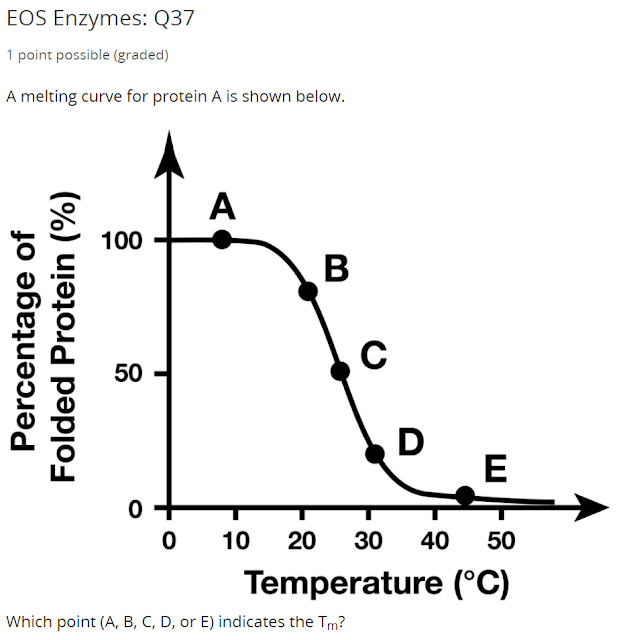I am really happy that I get this part all correct!
$ T_m $ is the temperature when 50% of the protein denatures. Therefore the answer is C.
The individual has antigen A and B expressed on the cell, so he don't have anti-body A or B, he can receive all blood types.
The higher the catalytic activity, the more elimination of hydrogen-halide is going on. Hydrogen halide will disassociate in aqueous solution and form hydrogen ion, so the pH will decrease, the less red will result.
Therefore the answer is A - it has least red and highest catalytic activity.
A is the best because it reacts with the mediator more than with oxygen. B react with mediator well as well, but it also react well with oxygen, the net difference is not as high as A does.
IMAGE NEEDS ALT TEXT? LOL...!
This problem is hard, I think more a long while - you want the $ k_m $ to me low because then the enzyme has high affinity, and you want $ k_{cat} $ to be high, because then the reaction is fast.
The one with low $ k_m $ and high $ k_{cat} $ for NADH is C.
The one with low $ k_m $ and high $ k_{cat} $ for NADPH is A. arguably, the WT works the best, but that's not an option.
This one is easy, you want to decrease red signal for lower pH just like problem 39 and you want decreased NADH level if you want it to react.
$ T_m $ is the temperature when 50% of the protein denatures. Therefore the answer is C.
The individual has antigen A and B expressed on the cell, so he don't have anti-body A or B, he can receive all blood types.
The higher the catalytic activity, the more elimination of hydrogen-halide is going on. Hydrogen halide will disassociate in aqueous solution and form hydrogen ion, so the pH will decrease, the less red will result.
Therefore the answer is A - it has least red and highest catalytic activity.
A is the best because it reacts with the mediator more than with oxygen. B react with mediator well as well, but it also react well with oxygen, the net difference is not as high as A does.
IMAGE NEEDS ALT TEXT? LOL...!
This problem is hard, I think more a long while - you want the $ k_m $ to me low because then the enzyme has high affinity, and you want $ k_{cat} $ to be high, because then the reaction is fast.
The one with low $ k_m $ and high $ k_{cat} $ for NADH is C.
The one with low $ k_m $ and high $ k_{cat} $ for NADPH is A. arguably, the WT works the best, but that's not an option.
This one is easy, you want to decrease red signal for lower pH just like problem 39 and you want decreased NADH level if you want it to react.







No comments:
Post a Comment